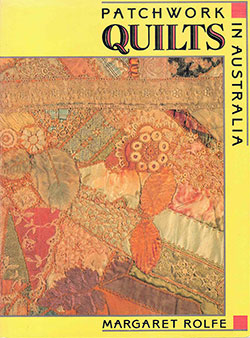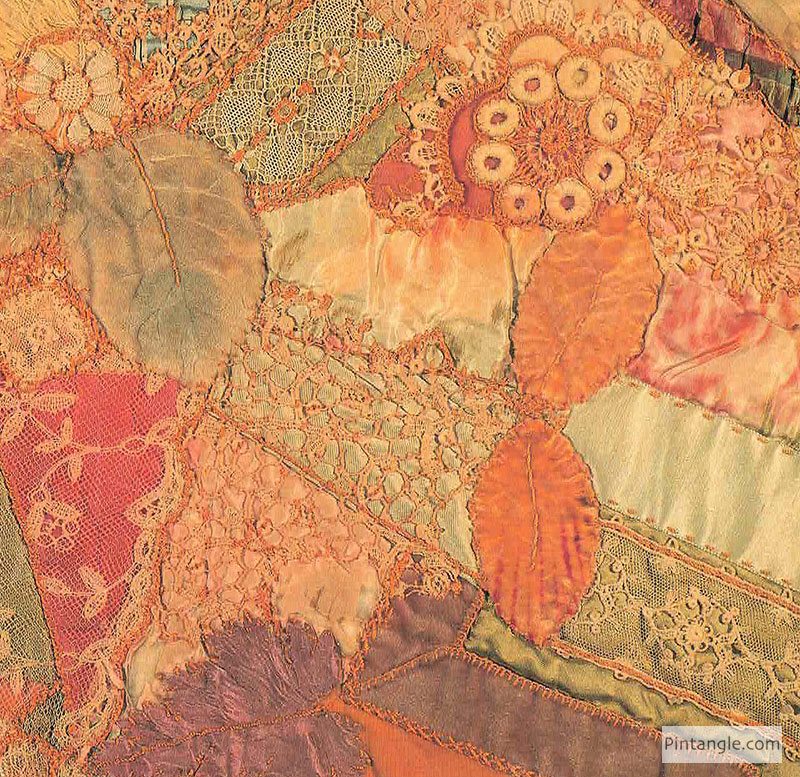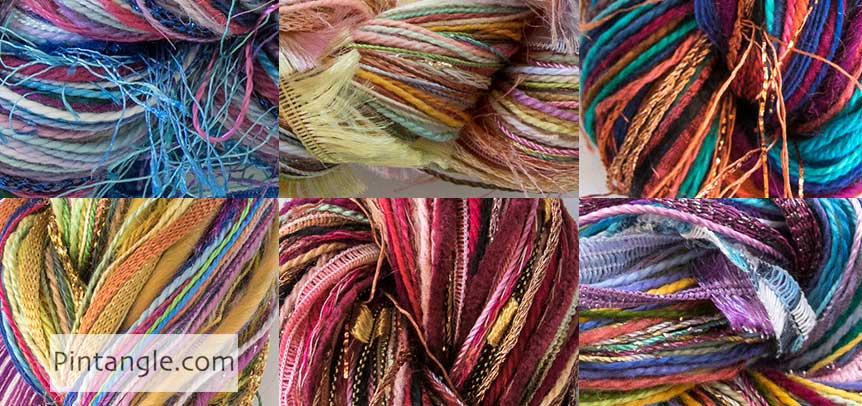Do you remember seeing a quilt or a textile that heavily influenced your journey into fibre and textiles? Something that made you say to yourself: ‘Oh! I need this sort of stitching in my life’. Something once seen you can’t un-see. A piece that tickles the edge of your brain constantly.
I have a few textiles like that. Today I am going to talk about a quilt that I saw over 30 years ago but still influences my work today.
The Margaret Weir quilt is held by the National Gallery of Australia and has taken me down a wonderful path of fabric, lace, ribbons, and embroidery. Margaret Weir was busily stitching her very unusual quilt around 1910. Information about this quilt online is very sparse. You can see a small photo of the quilt on the Australian Museums and Galleries website.
 The Margaret Weir quilt appears on the cover of Margaret Rolfe’s 1987 book Patchwork Quilts in Australia. A detail is featured on the cover. I have scanned it and shared it here so you can see what I am talking about.
The Margaret Weir quilt appears on the cover of Margaret Rolfe’s 1987 book Patchwork Quilts in Australia. A detail is featured on the cover. I have scanned it and shared it here so you can see what I am talking about.
Classified as a crazy quilt, it is a wonderful example of how the “no rules” philosophy applied. When anyone states categorically that old crazy quilts were never embellished as heavily as contemporary quilts, I try and find a tactful way to point to this one, as Margaret Weir integrated lace and embroidery so extensively you often can not see the background fabric. The quilt also has wadding which is also interesting another misconception people have is that the old crazy quilts never had batting. Some did as even then.
 You can see from this detail how, as a quilt, it is strikingly different from other crazy quilts. (Click on the image for a larger view) What strikes me is that this quilt feels like a contemporary piece, yet it was stitched at the beginning of last century. What gives it that contemporary feel? I think it is that Margaret Weir layered her work just as many slow stitch, freeform, contemporary embroiderers do today. By layering, I mean not only the physical layers of lace and fabric and the leaf shapes, but in her choice of materials and stitches Margaret Weir creates an impression of depth. I always feel like I am going to fall into the quilt on one hand and on the other, that the quilt might represent an aerial view of the landscape.
You can see from this detail how, as a quilt, it is strikingly different from other crazy quilts. (Click on the image for a larger view) What strikes me is that this quilt feels like a contemporary piece, yet it was stitched at the beginning of last century. What gives it that contemporary feel? I think it is that Margaret Weir layered her work just as many slow stitch, freeform, contemporary embroiderers do today. By layering, I mean not only the physical layers of lace and fabric and the leaf shapes, but in her choice of materials and stitches Margaret Weir creates an impression of depth. I always feel like I am going to fall into the quilt on one hand and on the other, that the quilt might represent an aerial view of the landscape.
 Not only has Margaret Weir influenced my crazy quilting but she also has influenced my freeform contemporary work too. To illustrate here. These details are part of a fabric book I am working on. I am still working on it – so I guess you can call it a WISP rather than WIP. In other words a Work In Slow Progress instead of a Work In Progress. But that is what Slow stitching is about isn’t it? Anyway, you can see the layering of stitches, sari ribbon, crochet lace, lace, the old gold padded tube knitting ribbon and beads of course!
Not only has Margaret Weir influenced my crazy quilting but she also has influenced my freeform contemporary work too. To illustrate here. These details are part of a fabric book I am working on. I am still working on it – so I guess you can call it a WISP rather than WIP. In other words a Work In Slow Progress instead of a Work In Progress. But that is what Slow stitching is about isn’t it? Anyway, you can see the layering of stitches, sari ribbon, crochet lace, lace, the old gold padded tube knitting ribbon and beads of course!
Another detail of a separate section in the same project. I am sure you can see the influence. If you want to read more about my fabric book in progress visit this page
Another example of layering, but not quite so heavy-handed with the ‘stuff’ is this section of a wall hanging. I worked this for my book Creative Stitches for Contemporary Embroidery. I used many sections of this panel as illustrations for stitches. This is another detail of the same wall piece.
As I write I have decided that it is not finished yet as I want to add more layers. I think it will add more visual interest. So I guess for this project it is back in the Slow stitch basket. those WISPs are growing!
Do you have a textile that launched you on a creative journey? Something that when you saw it, made you think, I must to learn how to do that! Let me know in the comments below. I would love to hear about it!
Thread Twisties!

Experimenting with different threads can be expensive. You would normally have to buy a whole skein of each type of thread. My thread twisties are a combination of different threads to use in creative hand embroidery. These enable you to try out stitching with something other than stranded cotton. For the price of just a few skeins, you can experiment with a bundle of threads of luscious colours and many different textures.
These are creative embroiders threads. With them, I hope to encourage you to experiment. Each Twistie is a thread bundle containing silk, cotton, rayon and wool. Threads range from extra fine (the same thickness as 1 strand of embroidery floss) to chunky couchable textured yarns. All threads have a soft and manageable drape. Twisting them around a needle makes experimental hand embroidery an interesting journey rather than a battle. Many are hand dyed by me. All are threads I use. You may find a similar thread twist but no two are identical.
You will find my thread twisties in the Pintangle shop here.




Hi Sharon, having been a dressmaker since my teen years, sewing is second nature. I retired in 1992, having turned my passion for sewing into a business, which was very successful. As my main customers were brides-to-be, there was lots of hand sewing and beading involved. When I retired I missed my sewing very badly.
However, rescue was at hand! I attended the opening of an exhibition by our local Quilters group, and a lovely lady named Phyl guided me around the stunning quilts on show, and I was hooked! Then I discovered Pintangle, and what an eye opener that was! I knew CP existed but had not taken a great deal of interest. Crazy Patch kept me sane while we were in lockdown last year, and I am constantly either CP-ing or embellishing. It has also inspired me to learn free form embroidery which I love. Thank you Sharon for your constant inspiration and the many things you teach us
Thanks Joan I am so pleased you discovered Crazy quilting – it is a technique that has kept me interested for 30 years – I hope it brings you many happy stitching hours
I was first incredibly inspired by something called “i dropped the button box”. I am for real, and not just saying that. Your work continues to amaze me and thank you so much for all you share!!
Oh! CaLynn thanks – I am pleased you like the site
Hi Sharon,
After I retired, my husband died and I moved from Cambridgeshire to Yorkshire I needed to find something to occupy my time. I had not done any needlework since my children were tiny – a long, long time. My daughter suggested that I look through Pinterest to get some idea of what I wanted to do. Hail Pinterest! I found crazy quilting and fell in love. The first people to bring this wonderful art form into my life were Pamela Kellogg, Manya from Romania and, by no means least a lady called Sharon Boggon. I can’t thank you all enough for the pleasure you have brought me over the last 10 years and still enjoying finding new things for me to try.g
Oh Thanks Gillian it is so nice to know the site brings joy to people
Three pieces came together to form my inspiration. The first was a gorgeous old crazy quilt done by my great grandmother out of old patches of clothing, including a lot of velvets and wools and embroidery stitches with differing thread weights–the first time I had seen such a thing. The tactile nature of it was divine and appealed to me even as a child. Later, I spotted a gorgeous negative space dragon embroidered by Annett that gave me that same sense of captivation. I loved diving into the complexity and yet simplicity of the work, and in following her blog, discovered your encrusted embroidery classes, and I was hooked the moment I saw your crazy quilt work.
HI Andi – thanks interesting you mention the encrusted embroidery as I have recently been asked to produce patterns for some of my designs. Pleased you liked the class!
Two specific items have inspired me greatly, they are both from the collection of The Quilters’ Guild of the British Isles. One is the Flower Tea Cosy, early 20th century and the other a Silk and velvet Jubilee Quilt, made in 1887 by Mrs Mills. In both you have the marriage of lush fabric and heavy embroidery.
In school I had done both patchwork and embroidery, but not grasped how good they would look together.
The other great inspiration for me is YOU and your crazy quilting. Ever since I saw what can be done with lace, buttons as well as embroidery I was hooked. I joined TAST 2012 and started adding the stitches I learned to my patchwork and quilting, and then crazy quilting. I have hardly had a stitch free day since.
The Margaret Weir quilt is truly stunning. Is all of it in the same autumnal hues? There is something very powerful with a monochrome crazy quilt, especially when they layers are so thick.
Your fabric book is oozing beauty. Keep up your WISP and keep on inspiring us.
Hi Queenie great to see your name pop up here – the quilt is almost monotone and not quite as orange as the photo suggests due to 80s photography and printing technology. The lace makes it more pastel in tones.
I can’t imagine not stitching – so that WISP will get done eventually which means until my hands give out you have to put up with me babbling on!
When studying in France in 1983-84, I drooled over a stunning sweater in a yarn shop. I don’t know if it was knit or crocheted, or perhaps both; it was in creams and whites, made of richly textured rectangles and squares, like a sampler. I suspect it was achieved using many different stitches. I could not afford it, but it lingers in my memory even today.
A second item was a quilt I saw somewhere in 1981-83 at a quilt show in Moscow, Idaho, USA, before I really knew anything about quilting. It was embellished with 3-dimensional red to maroon hued velvet and velveteen roses and rosebuds on bias stems. I have no idea what the stems were made of, the background color of the quilt, who made it or when it was made. I just remember those gorgeous roses, made of velvets and velveteens. It inspired my dream to make a Baltimore Album quilt-which is still on my bucket list.
Thanks for your wonderful posts, books, and for sharing your talent and your work. You are inspirational.
Thanks so much for your comment – I wonder how the velvet roses were made? I find it totally fascinating how we can see a piece – a textile- and carry it with us for so many years, vividly in our minds eye.
Not one specific textile but a few… I saw a cardigan made from free form crochet and loved it, but had no idea how to do it. Then I saw a few examples of Irish crochet lace and I am in love, and filled with ideas of how to take the basic, traditional idea and make it my own.
Hi Nicola thanks for answering – how interesting as I love free form crochet too – love the texture and how when you suint your eyes some of it can look like free form crochet.
My CQ journey began after buying the Winter 2003 edition of Belle Armoire and seeing the Victorian jacket article, starting on page 40 of that magazine. I no longer have the magazine, but I do have the pages from that magazine, documenting that jacket. Since I had never done any CQ before, I started buying books about the subject, including those by Judith Baker Montano and J. Marsha Michler for a start and then any others that I could find! I also started hoarding high end black fabrics, buying just the minimum cut of each. Also black embellishments, and everything had to be black black; not grey black; not brown black; not blue black. BLACK! I also started a CQ jacket made from my sewing scraps from previous years and in various colours. I was not going to use the high end black fabrics until I had experimented a little with sewing scraps. It took me 7 years, but I made a CQ jacket using the old sewing scraps. I entered it in two shows. One in Edmonton, AB, a quilting show, where it won a red (first prize) ribbon in it’s category. I then entered it in the Calgary Stampede in Calgary, AB where it also won a red ribbon as well as best of show in it’s category. Two years later I entered the little black CQ jacket in the Calgary Stampede where it won a 3rd prize in it’s category. I am now retired and still crazy quilting. All because of that little black jacket pictured in a magazine in 2003.
Hi Grovenore – great story I have often thought about CQ clothing made the odd hat and some waistcoats used by circus performers (those were just crazy patched not hand embroidered!) but that is is it. I find stories like this wonderful how true inspiration can push your stitching further to a first class standard as your awards testify. Congratulations.
Dear Sharon,
YES, YOUR work has and still does inspire me. Your dropped the button box is one example. I LOVE seeing every block you do, and your post is very interesting, to see how indeed, Margaret Weir’s quilt influenced you. I’ve only dabbled in crazy quilting, a couple blocks partially finished, but I swear I want to sit down and seriously do lots more. You are an inspiration, and I love your tools and books too. Thank you for sharing your creativity and documenting so many stitches and history in your sampler too.
Best wishes, Jennifer P
OhJennifer thanks so much – find some time for yourself! Sit down and do some stitching – enjoy it